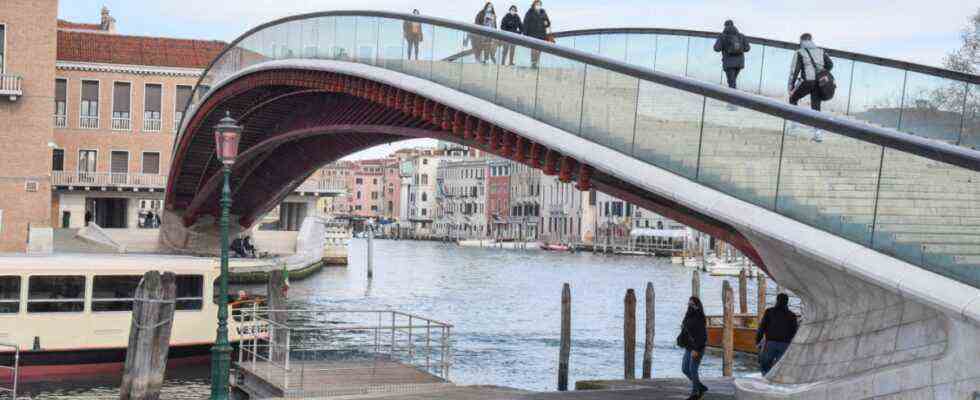Bridge building seems to be an entirely positive proposition. Those who build bridges mediate between cultures or disputes, overcome gaps and rifts, stand up against racism and for better understanding.
But building bridges can also be a consistently difficult matter. What you could last see in Venice, at the problem bridge called Ponte della Costituzione. The pedestrian bridge, designed by the Spanish-Swiss architect Santiago Calatrava and also called “Ponte Calatrava”, leads over the Grand Canal and connects the Santa Lucia train station with the Piazzale Roma. And has actually been causing difficulties since its inauguration in 2008.
At first it was more expensive than planned (11 instead of 6.7 million euros), then the construction of glass railings and glass steps (you should see the water of the canal) turned out to be slippery. Especially when it gets damp. So almost always in a lagoon.
Careful, slippery: the glass floor allows a view of the water of the Grand Canal under the bridge, but it has its pitfalls.
(Photo: Arnulf Hettrich / imago images)
Calatrava became therefore sentenced to a fine of 78,000 euros. The city closed the bridge in bad weather and put anti-slip strips on – to no avail. Now the administration has decided: The glass steps should be removed. Replaced by stone stairs, by plates made of trachyte. Half a million have been planned for 2022, according to the local government. City Planning Councilor Francesca Zaccariotto said the regional newspaper: “All of our previous attempts have achieved nothing: adhesive strips, resins, resins with quartz.”
The architect Calatrava, who sees himself as an artist, and his buildings in New York and Valencia, among others were many times more expensive than planned and repeatedly attracted attention due to incorrect planning, on the other hand, it was probably about the glass. This finally enables the wonderful view down, on Calatrava’s homepage the bridge is praised as a “decidedly new and decisive contribution to the Grand Canal”.
Too much momentum: The Millennium Bridge over the Thames had to be rebuilt shortly after it opened.
(Photo: imago images / YAY Images)
Now this design flaw rarely sounds stupid, but it is not. Immediately after their opening, other bridges also turned out to be bad planning. The Ponte Calatrava could hope that it will fare like the Millennium Bridge in London. It had to be closed again in 2000 and rebuilt because pedestrians made it vibrate too much. A good twenty years later, it was almost forgotten. The bridge is still standing, and it has made it into several films in brilliant supporting roles.
“We’re going in sackcloth,” said Deutsche Bahn
Anyone who mockingly locates such cases abroad, where one likes to look from Germany, if one wants to feel superior in terms of engineering, should be reminded of the Müngstener Brücke. The highest railway bridge in Germany connects Solingen and Remscheid and was noticed in 2011 because the railway forgot its passengers. The group had expected the wrong weight for maintenance work and accordingly made incorrect requests. As a result, the trains first had to run empty across the bridge. “We are sacked and ashes and have to apologize to the passengers,” said a railroad spokesman.
The passengers forget: The Müngstener Brücke is the highest railway bridge in Germany, but it made a name for itself in 2011 mainly because of a miscalculation by the railway.
(Photo: Oliver Langel Düsseldorf via www.imago-images.de/imago images / Oliver Langel)
In 2016, a nameless bridge over the B 255 near Niederahr in Rhineland-Palatinate made headlines. Its pillars were so close together that instead of four planned lanes only two lanes would fit underneath. The regional agency for mobility had to admit that the problems were only noticed after the advanced construction of the 50 million euro bypass road.
Laufenburg and Laufenburg found each other despite the differences.
(Photo: Xantana via www.imago-images.de/imago images / Xantana)
The Hochrheinbrücke between Laufenburg in Switzerland and Laufenburg in Baden proved that building bridges does not automatically cross borders. During international cooperation, it turned out that Swiss and Germans have different views when it comes to sea level. In Switzerland you orientate yourself on the Mediterranean Sea, in Germany on the North Sea, which of course results in a considerable difference in altitude.
That was originally taken into account – and then incorrectly calculated. The bridge halves were growing on both sides in 2004, until it was noticed that one side was 54 centimeters too low. At least the error could be corrected quickly and without additional costs. And without anyone having to break off all the bridges behind them.

